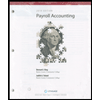
INTERMEDIATE ACCOUNTING
8th Edition
ISBN: 9780078025839
Author: J. David Spiceland
Publisher: McGraw-Hill Education
expand_more
expand_more
format_list_bulleted
Question
Chapter 12, Problem 12.25Q
To determine
Cash surrender value: Companies purchase whole-life insurance policies on the lives of the key officers. In the usual process, the beneficiary receives the insurance proceeds aft her the officer dies. But if the insurance policy is surrendered when the insured is still alive, the amount received in exchange for the surrender, is referred to as cash surrender value.
To explain: The process of accounting for cash surrender value
Expert Solution & Answer
Want to see the full answer?
Check out a sample textbook solution
Students have asked these similar questions
A company identifies two activities: material handling and machine setup. The cost drivers are number of parts (10,000) and number of setups (200), with cost pools of $250,000 and $180,000 respectively. Product A uses 2,500 parts and 50 setups. Calculate the activity-based overhead allocated to Product A.
Can you solve this financial accounting problem using appropriate financial principles?
Question 7-B
Chapter 12 Solutions
INTERMEDIATE ACCOUNTING
Ch. 12 - Prob. 12.1QCh. 12 - When market rates of interest rise after a...Ch. 12 - Does GAAP distinguish between fair values that are...Ch. 12 - When a debt investment is acquired to be held for...Ch. 12 - Prob. 12.5QCh. 12 - What is comprehensive income? Its composition...Ch. 12 - Why are holding gains and losses treated...Ch. 12 - Prob. 12.8QCh. 12 - Prob. 12.9QCh. 12 - Prob. 12.10Q
Ch. 12 - Prob. 12.11QCh. 12 - Prob. 12.12QCh. 12 - Do U.S. GAAP and IFRS differ in the amount of...Ch. 12 - Under what circumstances is the equity method used...Ch. 12 - The equity method has been referred to as a...Ch. 12 - In the application of the equity method, how...Ch. 12 - Prob. 12.17QCh. 12 - Prob. 12.18QCh. 12 - Prob. 12.19QCh. 12 - How does IFRS differ from U.S. GAAP with respect...Ch. 12 - What is the effect of a company electing the fair...Ch. 12 - Define a financial instrument. Provide three...Ch. 12 - Some financial instruments are called derivatives....Ch. 12 - Prob. 12.24QCh. 12 - Prob. 12.25QCh. 12 - Prob. 12.26QCh. 12 - (Based on Appendix 12B) Reporting an investment at...Ch. 12 - Prob. 12.28QCh. 12 - Explain how the CECL model (introduced in ASU No....Ch. 12 - Prob. 12.1BECh. 12 - Prob. 12.2BECh. 12 - Available -for-sale securities LO12-4 SL...Ch. 12 - Prob. 12.4BECh. 12 - Prob. 12.5BECh. 12 - Prob. 12.6BECh. 12 - Prob. 12.7BECh. 12 - Prob. 12.8BECh. 12 - Prob. 12.9BECh. 12 - Prob. 12.10BECh. 12 - Prob. 12.11BECh. 12 - Prob. 12.12BECh. 12 - Prob. 12.13BECh. 12 - Prob. 12.14BECh. 12 - Prob. 12.15BECh. 12 - Prob. 12.16BECh. 12 - Prob. 12.17BECh. 12 - Prob. 12.18BECh. 12 - Prob. 12.1ECh. 12 - Prob. 12.2ECh. 12 - Prob. 12.3ECh. 12 - Prob. 12.4ECh. 12 - Prob. 12.5ECh. 12 - Prob. 12.6ECh. 12 - Prob. 12.7ECh. 12 - Prob. 12.8ECh. 12 - Prob. 12.9ECh. 12 - Prob. 12.10ECh. 12 - Prob. 12.11ECh. 12 - Prob. 12.12ECh. 12 - Prob. 12.13ECh. 12 - Prob. 12.14ECh. 12 - Prob. 12.15ECh. 12 - Prob. 12.16ECh. 12 - Prob. 12.17ECh. 12 - Prob. 12.18ECh. 12 - Prob. 12.19ECh. 12 - Prob. 12.20ECh. 12 - Prob. 12.21ECh. 12 - Prob. 12.22ECh. 12 - Prob. 12.23ECh. 12 - Prob. 12.24ECh. 12 - Prob. 12.25ECh. 12 - Prob. 12.26ECh. 12 - Prob. 12.27ECh. 12 - Prob. 12.28ECh. 12 - Prob. 12.29ECh. 12 - Prob. 12.30ECh. 12 - Prob. 12.31ECh. 12 - Prob. 1CPACh. 12 - Prob. 2CPACh. 12 - Prob. 3CPACh. 12 - Prob. 4CPACh. 12 - Prob. 5CPACh. 12 - Prob. 6CPACh. 12 - Prob. 7CPACh. 12 - Prob. 8CPACh. 12 - Prob. 9CPACh. 12 - Prob. 10CPACh. 12 - Prob. 11CPACh. 12 - Prob. 12CPACh. 12 - Prob. 13CPACh. 12 - Prob. 1CMACh. 12 - Prob. 2CMACh. 12 - Prob. 3CMACh. 12 - Prob. 12.1PCh. 12 - Prob. 12.2PCh. 12 - Prob. 12.3PCh. 12 - Prob. 12.4PCh. 12 - Prob. 12.5PCh. 12 - Prob. 12.6PCh. 12 - Prob. 12.7PCh. 12 - Prob. 12.8PCh. 12 - Prob. 12.9PCh. 12 - Prob. 12.10PCh. 12 - Prob. 12.11PCh. 12 - Prob. 12.12PCh. 12 - Prob. 12.13PCh. 12 - P 12–14
Classifying investments
LO12–1 through...Ch. 12 - Prob. 12.15PCh. 12 - Prob. 12.16PCh. 12 - Prob. 12.17PCh. 12 - Prob. 12.18PCh. 12 - Prob. 12.1BYPCh. 12 - Prob. 12.2BYPCh. 12 - Case 12–4
Accounting for debt and equity...Ch. 12 - Prob. 12.6BYPCh. 12 - Prob. 12.7BYP
Knowledge Booster
Similar questions
arrow_back_ios
SEE MORE QUESTIONS
arrow_forward_ios
Recommended textbooks for you
 Intermediate Accounting: Reporting And AnalysisAccountingISBN:9781337788281Author:James M. Wahlen, Jefferson P. Jones, Donald PagachPublisher:Cengage Learning
Intermediate Accounting: Reporting And AnalysisAccountingISBN:9781337788281Author:James M. Wahlen, Jefferson P. Jones, Donald PagachPublisher:Cengage Learning
 Essentials of Business Analytics (MindTap Course ...StatisticsISBN:9781305627734Author:Jeffrey D. Camm, James J. Cochran, Michael J. Fry, Jeffrey W. Ohlmann, David R. AndersonPublisher:Cengage LearningBusiness/Professional Ethics Directors/Executives...AccountingISBN:9781337485913Author:BROOKSPublisher:Cengage
Essentials of Business Analytics (MindTap Course ...StatisticsISBN:9781305627734Author:Jeffrey D. Camm, James J. Cochran, Michael J. Fry, Jeffrey W. Ohlmann, David R. AndersonPublisher:Cengage LearningBusiness/Professional Ethics Directors/Executives...AccountingISBN:9781337485913Author:BROOKSPublisher:Cengage


Intermediate Accounting: Reporting And Analysis
Accounting
ISBN:9781337788281
Author:James M. Wahlen, Jefferson P. Jones, Donald Pagach
Publisher:Cengage Learning



Essentials of Business Analytics (MindTap Course ...
Statistics
ISBN:9781305627734
Author:Jeffrey D. Camm, James J. Cochran, Michael J. Fry, Jeffrey W. Ohlmann, David R. Anderson
Publisher:Cengage Learning

Business/Professional Ethics Directors/Executives...
Accounting
ISBN:9781337485913
Author:BROOKS
Publisher:Cengage